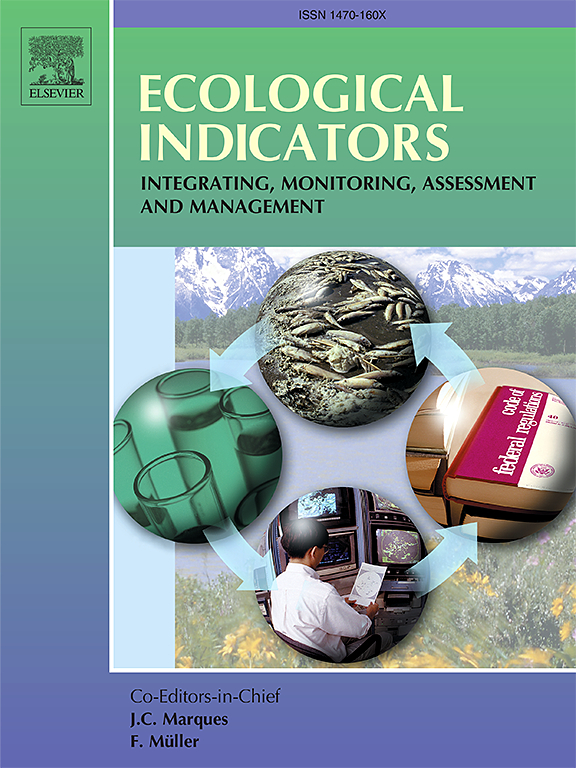Introducing evascape, a model-based soundscape assembler: impact of background sounds on biodiversity monitoring with ecoacoustic indices
IF 7
2区 环境科学与生态学
Q1 ENVIRONMENTAL SCIENCES
引用次数: 0
Abstract
The development of ecoacoustics and soundscape ecology is linked to the development of field recording techniques and the production of large and diverse sound databases representative of various environments. However, an important caveat in this approach lies in the lack of reference data, limiting the possibility of developing acoustic biodiversity indices and assessing their sensitivity to environmental change. To address this issue, previous studies have attempted to generate “engineered soundscapes”, that is artificial soundscape recordings which offer some control on, among other aspects, species diversity. Unfortunately, these tools lack complexity and realism, limiting their ecological validity. Here, we introduce Evascape, a Python algorithm informed by available knowledge in soundscape ecology aiming at producing assembled soundscapes with high ecological validity. The algorithm offers the possibility to control biophony (number of species, number of individuals, time organization), geophony (wind and rain with adjustable level), anthropophony (aircraft noise) and sound propagation effects (frequency-dependent attenuation function of the habitat). The algorithm was tested using an acoustic database collected in a protected European cold forest. The generated assembled soundscapes were then used to assess a selection of commonly-used ecoacoustic indices across a large number of controlled scenarios, and to identify the indices that respond most strongly to changes in species richness. Evascape opens the path to other ecoacoustics-related research programs, offering the possibility to design empirical and computational experiments with controlled soundscape parameters.
介绍了基于模型的声景观组装器evascape:背景声对生物多样性生态声学监测的影响
生态声学和声景生态学的发展与现场录音技术的发展以及代表各种环境的大型和多样化声音数据库的产生有关。然而,该方法的一个重要缺点是缺乏参考数据,限制了建立声生物多样性指数和评估其对环境变化敏感性的可能性。为了解决这个问题,以前的研究试图产生“工程音景”,即人工音景录音,在其他方面,对物种多样性提供一些控制。不幸的是,这些工具缺乏复杂性和现实性,限制了它们的生态有效性。本文介绍了一种基于声景生态学知识的Python算法Evascape,该算法旨在生成具有高生态有效性的组合声景。该算法提供了控制生物噪声(物种数量、个体数量、时间组织)、地质噪声(可调节水平的风雨)、人类噪声(飞机噪声)和声音传播效应(栖息地的频率相关衰减函数)的可能性。该算法使用在欧洲受保护的寒冷森林中收集的声学数据库进行了测试。生成的组合声景观随后被用于评估在大量控制情景中选择的常用生态声学指数,并确定对物种丰富度变化响应最强烈的指数。Evascape为其他生态声学相关的研究项目开辟了道路,提供了在受控声景参数下设计经验和计算实验的可能性。
本文章由计算机程序翻译,如有差异,请以英文原文为准。
求助全文
约1分钟内获得全文
求助全文
来源期刊

Ecological Indicators
环境科学-环境科学
CiteScore
11.80
自引率
8.70%
发文量
1163
审稿时长
78 days
期刊介绍:
The ultimate aim of Ecological Indicators is to integrate the monitoring and assessment of ecological and environmental indicators with management practices. The journal provides a forum for the discussion of the applied scientific development and review of traditional indicator approaches as well as for theoretical, modelling and quantitative applications such as index development. Research into the following areas will be published.
• All aspects of ecological and environmental indicators and indices.
• New indicators, and new approaches and methods for indicator development, testing and use.
• Development and modelling of indices, e.g. application of indicator suites across multiple scales and resources.
• Analysis and research of resource, system- and scale-specific indicators.
• Methods for integration of social and other valuation metrics for the production of scientifically rigorous and politically-relevant assessments using indicator-based monitoring and assessment programs.
• How research indicators can be transformed into direct application for management purposes.
• Broader assessment objectives and methods, e.g. biodiversity, biological integrity, and sustainability, through the use of indicators.
• Resource-specific indicators such as landscape, agroecosystems, forests, wetlands, etc.
 求助内容:
求助内容: 应助结果提醒方式:
应助结果提醒方式:


